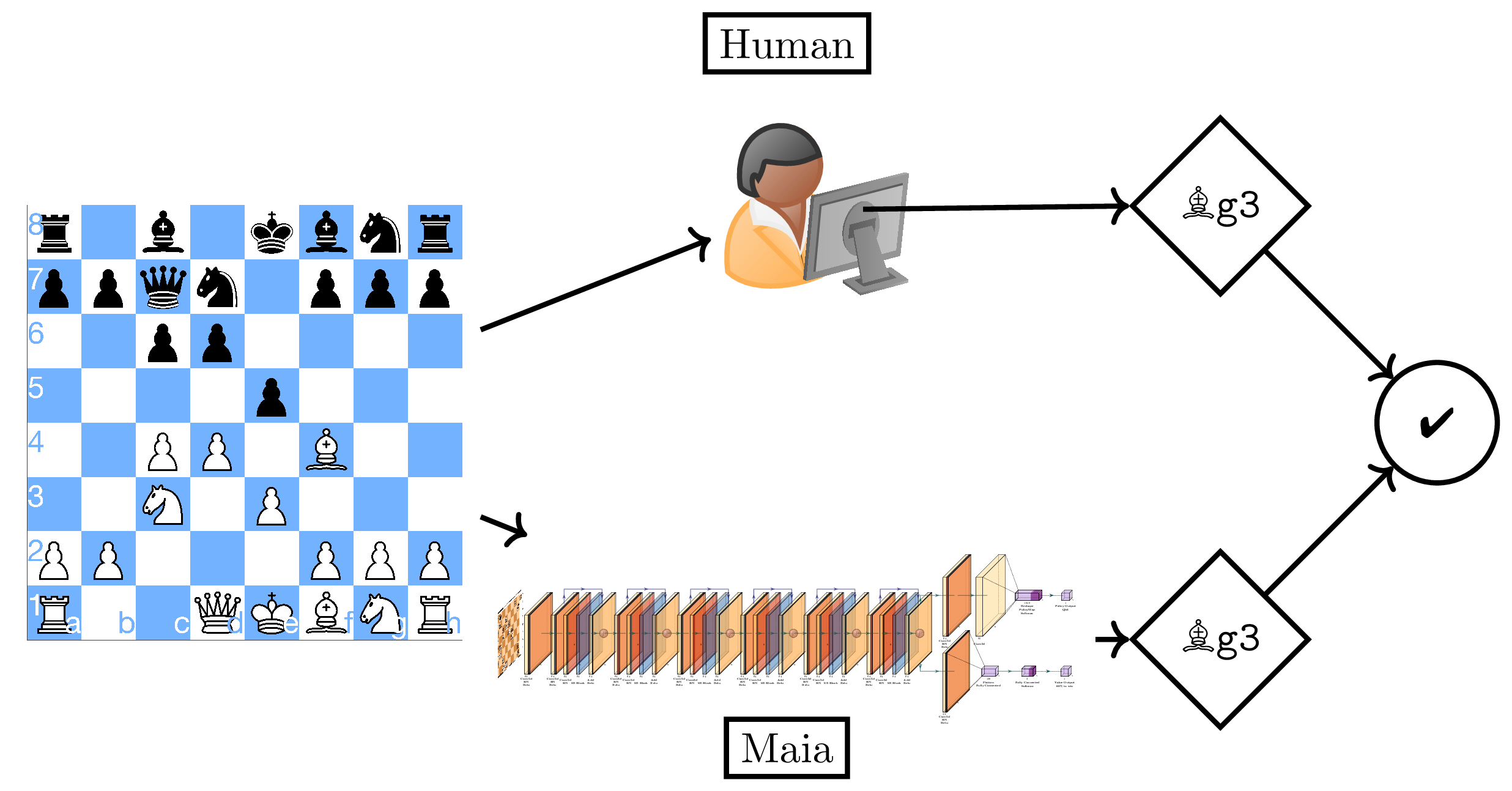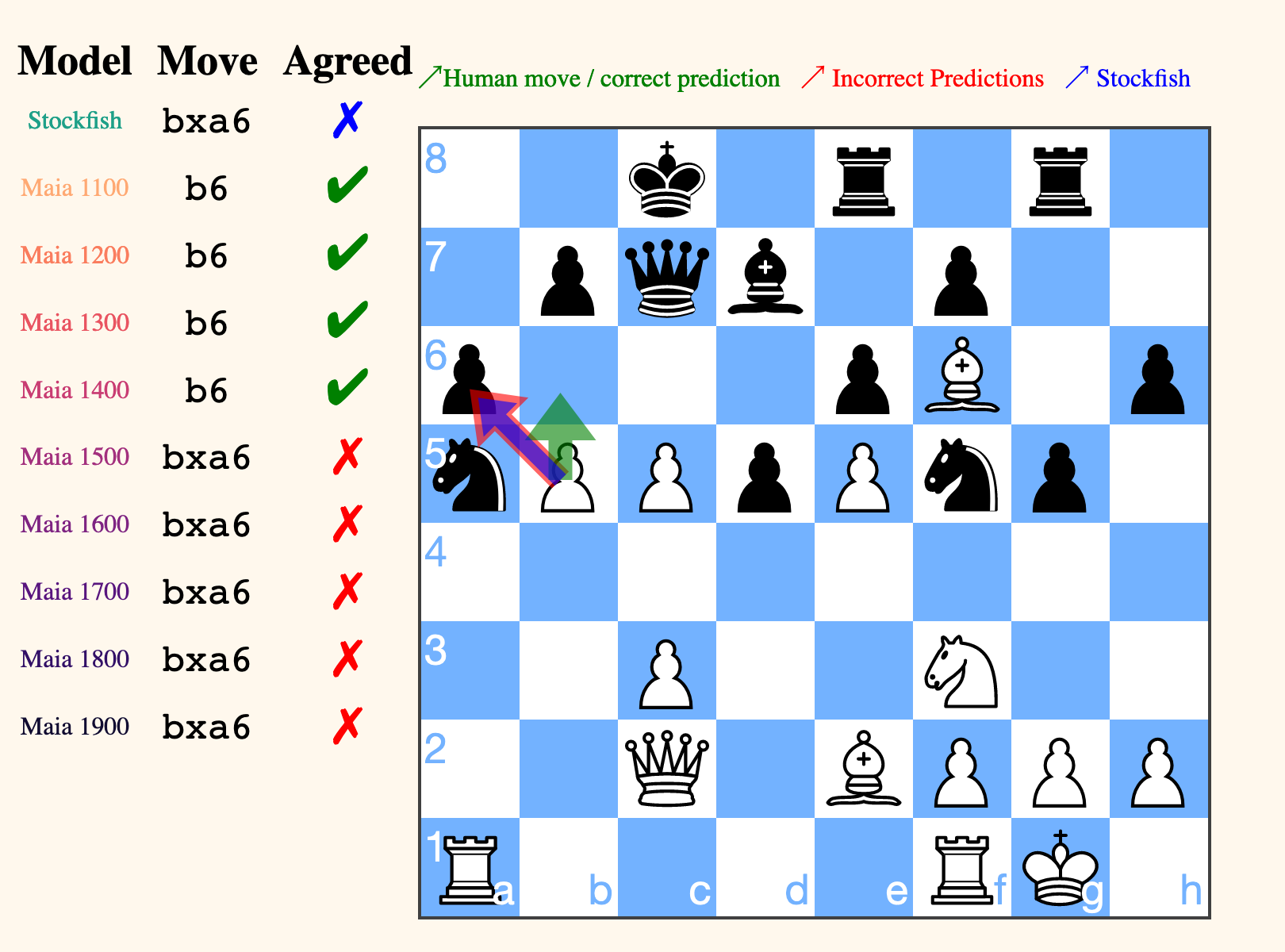

Maia Chess
source link: https://maiachess.com/
Go to the source link to view the article. You can view the picture content, updated content and better typesetting reading experience. If the link is broken, please click the button below to view the snapshot at that time.

Capturing human style in chess
Maia’s goal is to play the human move — not necessarily the best move. As a result, Maia has a more human-like style than previous engines, matching moves played by human players in online games over 50% of the time.
 During training, Maia is given a position that occurred in a real human game and tries to predict which move was made. After seeing hundreds of millions of positions, Maia accurately captures how people at different levels play chess.
During training, Maia is given a position that occurred in a real human game and tries to predict which move was made. After seeing hundreds of millions of positions, Maia accurately captures how people at different levels play chess.
Maia is an AlphaZero/Leela-like deep learning framework that learns from online human games instead of self-play. Maia is trained on millions of games, and tries to predict the human move played in each position seen.
We trained 9 versions of Maia, one for each Elo milestone between 1100 and 1900. Maia 1100 was only trained on games between 1100-rated players, and so on. Each version learned from 12 million human games, and learns how chess is typically played at its specific level.
We measure “move-matching accuracy”, how often Maia’s predicted move is the same as the human move played in real online games.
Because we trained 9 different versions of Maia, each at a targeted skill level, we can begin to algorithmically capture what kinds of mistakes players at specific skill levels make – and when people stop making them.
In this example, the Maias predict that people stop playing the tempting but wrong move b6 at around 1500.
 In this position, Maia levels 1100–1400 correctly predict that White will play the tempting but wrong
move
b6 (the move
played in the game). It threatens the Queen, but after …Qxc5 White’s big advantage is mostly gone. Maia levels
1500–1900
predict that, on average, players rated 1500 and above will play the correct bxa6, forcing the Queenside open to
decisive effect.
In this position, Maia levels 1100–1400 correctly predict that White will play the tempting but wrong
move
b6 (the move
played in the game). It threatens the Queen, but after …Qxc5 White’s big advantage is mostly gone. Maia levels
1500–1900
predict that, on average, players rated 1500 and above will play the correct bxa6, forcing the Queenside open to
decisive effect.
Maia captures human style at targeted skill levels
We tested each Maia on 9 sets of 500,000 positions that arose in real human games, one for each rating level between 1100 and 1900. Every Maia made a prediction for every position, and we measured its resulting move-matching accuracy on each set.
Each Maia captures human style at its targeted skill level. Lower Maias best predict moves played by lower-rated players, whereas higher Maias predict moves made by higher-rated players.
As a comparison, we looked at how depth-limited Stockfish does on the same prediction task. We ran various depth limits, ranging from only considering the current board (D01) to letting it search 15 plies ahead (D15). Depth-limited Stockfish is the most popular engine to play against for fun (e.g. the "Play with the Computer" feature on Lichess).
We also compared against a variety of Leela chess models, ranging from the very weak 800-rated version to a 3200-rating version.
Stockfish and Leela models don't predict human moves as well as Maia. Equally importantly, they don't match a targeted skill level: the curves in the graph are relatively flat across a wide range of human skill levels.
Predicting mistakes
Maia is particularly good at predicting human mistakes. The move-matching accuracy of any model increases with the quality of the move, since good moves are easier to predict. But even when players make horrific blunders, Maia correctly predicts the exact blunder they make around 25% of the time. This ability to understand how and when people are likely to make mistakes can make Maia a very useful learning tool.
Personalizing to Individual Players
 By targeting a specific player we can get even higher move prediction accuracy compared to Maias targeting just the player's rating.
By targeting a specific player we can get even higher move prediction accuracy compared to Maias targeting just the player's rating.
In current work, we are pushing the modeling of human play to the next level: can we predict the moves a particular human player would make? It turns out that personalizing Maia gives us our biggest performance gains. We achieve these results by fine-tuning Maia: starting with a base Maia, say Maia 1900, we update the model by continuing training on an individual player’s games. This plot shows that personalized Maias achieve up to 75% accuracy at predicting particular players' moves.
The paper for this work is available as a preprint here.
Play Maia and more
You can play against Maia yourself on Lichess! You can play Maia 1100, Maia 1500, and Maia 1900.
Maia is an ongoing research project using chess as a case study for how to design better human-AI interactions. We hope Maia becomes a useful learning tool and is fun to play against. Our research goals include personalizing Maia to individual players, characterizing the kinds of mistakes that are made at each rating level, running Maia on your games and spotting repeated, predictable mistakes, and more.
This is work in progress and we’d love to hear what you think. Please let us know if you have any feedback or questions by email or Twitter.
Recommend
-
 55
55
Chess without turns!
-
 53
53
GitHub is where people build software. More than 27 million people use GitHub to discover, fork, and contribute to over 80 million projects.
-
 34
34
552 IEEE TRANSACTIONS ON PATTERN ANALYSIS AND MACHINE INTEL...
-
 53
53
I am practicing my machine learning (ML) skills and became curious if chess moves could be predicted, somehow. Crazy right? ;-) tldr: chess.py
-
 7
7
Maia active,做运动女孩的「姐妹」
-
 7
7
MAIA ACTIVE:如何实现在细分市场年销售额破5亿? ...
-
 9
9
收购MAIA ACTIVE,安踏需要中国版lululemon精练GymSquare·2023-10-16 10:28收购MAIA ACTIVE,安踏需要中国版lululemon。...
-
 5
5
安踏收购MAIA ACTIVE,一桩皆大欢喜的生意 行业人士都说:久违的好消息。 安踏的收购帝国再添一子,这次侵入了lululemon把控的女性瑜伽鞋服领域。2023年10月16日,安踏体育用品有限公司发布《收购MAIA ACTIVE业务》公告,公告称安踏...
-
 7
7
安踏收购74天,MAIA创始人出走中国企业家杂志·2024-01-01 09:45被动还是主动?被安踏正式收购74天之后,国产头部瑜伽服品...
-
 8
8
About Joyk
Aggregate valuable and interesting links.
Joyk means Joy of geeK